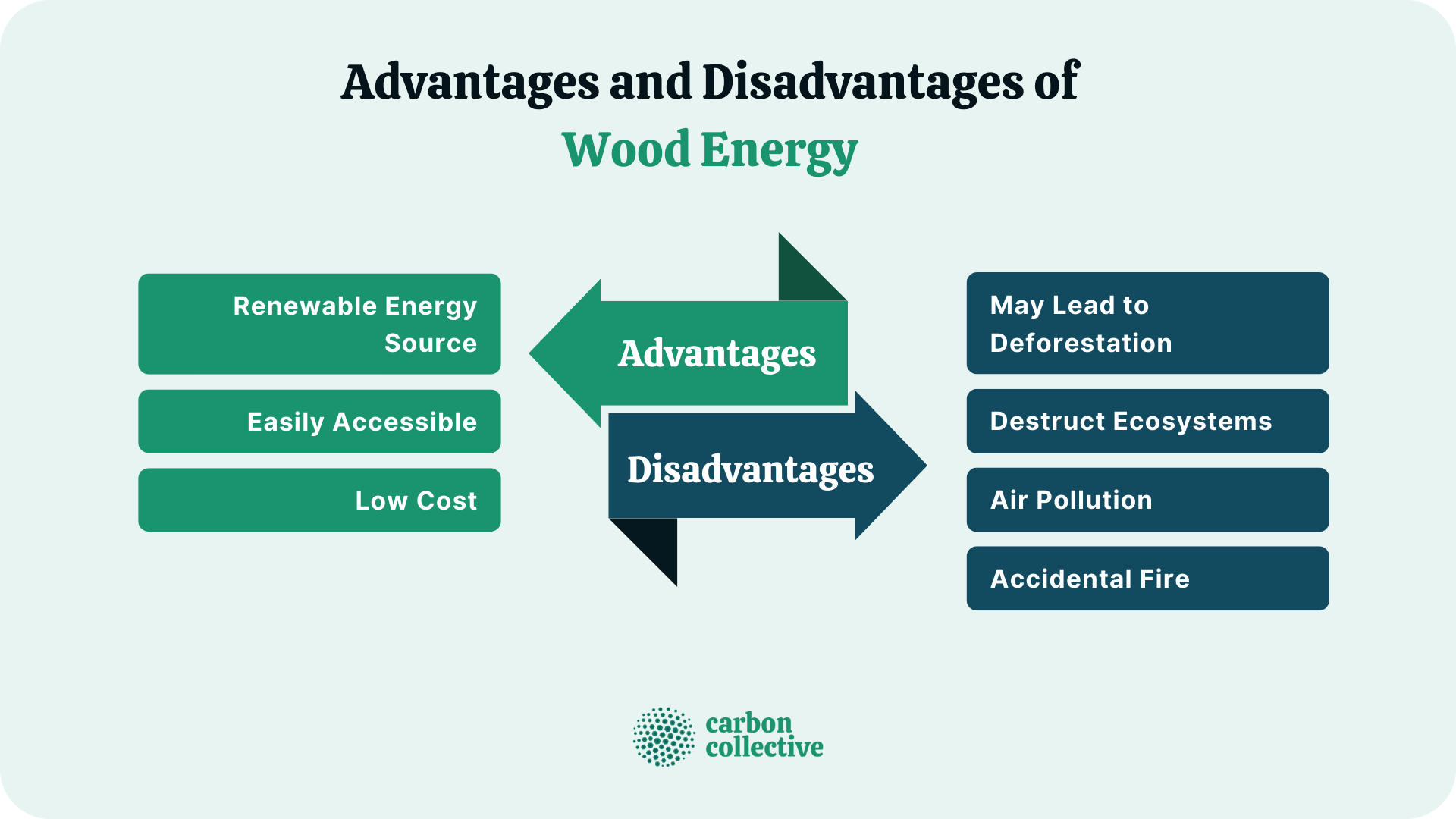Wood energy, also known as biomass energy, is any form of energy that comes from burning wood or wood products.
How Does Wood Energy Work?
Wood is the oldest source of energy on the planet.
According to the Food and Agriculture Organization of the United Nations, it is considered the most important single source of renewable energy that provides approximately six percent of the global total primary energy supply.
This kind of energy is generated through the combustion of wood pellets, wood briquettes, or whole trees for cooking or heating.
It is seen to be the only domestically available and most affordable renewable energy option for communities. Most households depend on this energy for fuel, heating, and cooking.
Because biomass fuels are carbon-neutral, wood energy has also been seen to be a solution for limiting greenhouse gas emissions associated with both transportation and electrical power generation.
Why Use Wood Energy?
There are many reasons to use this kind of energy as a renewable source of electricity.
Wood is a readily available and abundant resource. It provides a reliable supply of fuel. It does not go through a complicated production like mining for fossil fuels.
It has the smallest carbon footprint compared to other forms of renewable power generation because it emits less CO2 when burned. Since trees absorb atmospheric CO2 as they grow, using wood energy helps reduce air pollution levels.
Advantages of Wood Energy
Renewable Energy Source
Wood energy, like most other forms of renewable power generation, is considered to be green compared to more conventional power sources such as oil and coal.
Using biomass instead of fossil fuels results in less air pollution. Wood-based power plants release fewer emissions per unit of power than their fossil fuel counterparts.
Burning biomass emits carbon dioxide, but CO2 emissions from wood-burning are partially offset by photosynthesis when the plants absorb CO2 during the growing process.
Easily Accessible
Wood energy is a readily available and abundant resource. Wood is a crop residue that can be grown in forests specifically for the purpose of providing biomass energy.
Wood products such as pellets, briquettes, and chips are made from trees cut specifically to be used as energy sources.
Low Cost
Wood is considered one of the most affordable renewable forms of power generation. It is used domestically and provides a valuable source of income to rural households. It also costs less to transport compared to other fuel sources.
Since wood-based power plants do not have complex machinery or extensive infrastructure requiring high capital investments, they can be built at lower costs in isolated areas far from main energy grids.
Disadvantages of Wood Energy
May Lead to Deforestation
Using wood as a source of fuel accelerates deforestation and poses a threat to biodiversity. Forests provide valuable habitats for plants and animals that help humans survive, such as food sources.
Forests also help reduce atmospheric carbon dioxide levels by absorbing CO2 from the atmosphere through photosynthesis. Cutting down trees for biomass energy releases stored CO2 into the atmosphere, changing global climate patterns.
Forest fires can also release vast amounts of carbon dioxide, so burning forest areas contributes to greenhouse gas emissions as well as air pollution.
Ecosystems Destruction
When forests are cleared to generate electricity or heat, ecosystems are destroyed along with them. Trees have a specific microclimate that is home to many living organisms, some of which cannot be found anywhere else.
When the trees are burned, these ecosystems and their inhabitants die along with them.
Air Pollution
Burning biomass emits carbon dioxide, but CO2 emissions from wood-burning are partially offset by photosynthesis when the plants absorb CO2 during the growing process as mentioned above.
However, burning biofuels produces other harmful emissions such as nitrogen oxides (NOx), sulfur dioxides (SOx), particulate matter, and even toxic ash.
In fact, wood fire is considered one of the most polluting energy sources since it emits high amounts of organic particles.
Accidental Fire
Wood fires are difficult to control. These may result in forest fires that burn vast areas of land, displacing wildlife and destroying ecosystems.
Particularly dry areas that have seen widespread deforestation are at even higher risk of being destroyed by uncontrollable fire outbreaks.
The Bottom Line
Wood energy is an important renewable form of power generation that can be used domestically to provide electricity and heat for homes at cheaper costs while supplementing local incomes.
However, using wood-based power plants may lead to deforestation and air pollution. Accidental forest fires can also be a significant risk of using this form of energy.
Wood should therefore be used as an alternative to fossil fuels rather than as a primary source of power generation. Frequent cleaning and reforestation should be adopted, along with measures for preventing uncontrolled fires from breaking out.
To keep a balance between deforestation and using wood as a source of energy, countries need to develop sustainable practices for harvesting forest biomass so only dead material is used, not live trees.
For example, by planting fast-growing species close together instead of clear-cutting large areas at once, biomass can be harvested frequently and the trees continue to grow. Every year, a portion of biomass can be harvested from forests without significant harm to their microclimate.
FAQs
1. What is particulate matter?
Particulate matter is any tiny solid or liquid matter that is found in the air. It can be either made up of natural sources, such as soil and dust, or man made substances emitted through smoke and emissions from factories and automobiles.
2. What are the effects of particulate matter on humans? How does it affect ecosystems?
Particulate matter has major adverse effects on human health by penetrating lungs and bloodstreams bringing with it cancer-causing chemicals like arsenic. Particulate matter also damages ecosystems that support plant life by blocking sunlight.
3. What are some alternatives to using wood as energy?
Alternatives include wind energy, solar power, hydropower, and geothermal power.
4. How do you prevent forest fires from starting and spreading?
Forests can be protected by regularly cleaning up dead branches and leaves, planting fast-growing species of trees, and preventing the buildup of combustible materials like dry shrubs. Another way to keep fires under control is through controlled burning practices that help prevent future outbreaks.
5. How do you analyze whether or not it is appropriate to use biomass for producing energy?
It depends on how much forest biomass is being harvested annually compared to the plant growth rate. If the yield is sustainable, harvesting will neither deplete nor destroy forests. Sustainability is a question of balance between harvesting and forest regrowth.

